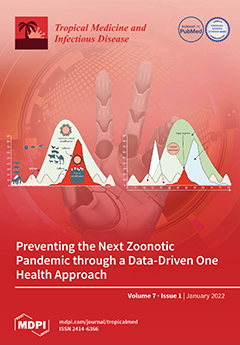(1) Background: This study aims to assess the magnitude of, and factors associated with, depression and anxiety among Vietnamese frontline hospital healthcare workers in the fourth wave of COVID-19; (2) Methods: A hospital based cross-sectional study was carried out within two weeks, October 2020, at a central COVID-19 treatment hospital. Depression and anxiety were measured with PHQ-9 and GAD-7, respectively. Bivariate and multivariate logistic regression analysis were applied to recognize variables related to depression and anxiety, respectively; (3) Results: Among 208 frontline hospital healthcare workers, overall prevalence of depressive symptoms, anxiety symptoms, and both symptoms of depression and anxiety was 38.94%, 25.48% and 24.04%, respectively, in healthcare workers. In a reduced model after using multivariate stepwise logistic regression, age (OR = 0.9,
p = 0.001), marital status (OR = 7.84,
p = 0.027), profession (OR = 0.39,
p = 0.028), having experienced traumatic stress following a work event (OR = 46.24,
p < 0.001), feeling at very high risk for COVID-19 (OR = 0.02,
p < 0.04), and affected by workplace conditions (OR = 5.36,
p < 0.001) were associated with the symptoms of depression. With regard to symptoms of anxiety, single status (OR: 12.18,
p = 0.002), being medical technician (OR: 68.89,
p < 0.001), alcohol use (OR: 6.83,
p = 0.014), using pain relief medications (OR: 25.50,
p = 0.047), having experienced traumatic stress following a family event (OR: 130.32,
p = 0.001), having experienced traumatic stress following a work event (OR: 181.55,
p = 0.002), reporting at very high risk for COVID-19 (OR: 29.64,
p = 0.011), treating moderate (OR: 6.46,
p = 0.038) and severe (OR: 18.96,
p = 0.004) COVID-19 patients, and being significantly affected by the community (OR: 6.33,
p = 0.003) were increased risk factors for the symptoms of anxiety. Meanwhile, those living with 4–5 people (OR: 0.15,
p = 0.011), specializing in infectious disease (OR: 0.13,
p = 0.044)/resuscitation and emergency medicine (OR: 0.04,
p = 0.046), and having knowledge preparation before participating in COVID-19 (OR: 0.008,
p = 0.014) were less associated with the symptoms of anxiety; (4) Conclusions: There was a relatively high prevalence among Vietnamese hospital healthcare workers exhibiting symptoms of depression and anxiety during the ongoing pandemic. Greater attention to training in psychological skills should be suggested for those belonging to a younger age group, being single/widowed/divorced, treating moderate and severe COVID-19 patients, feeling at very high risk for COVID-19, being significantly affected a lot the community or workplace conditions, or experiencing traumatic stress following a family/work event in the past week.
Full article






